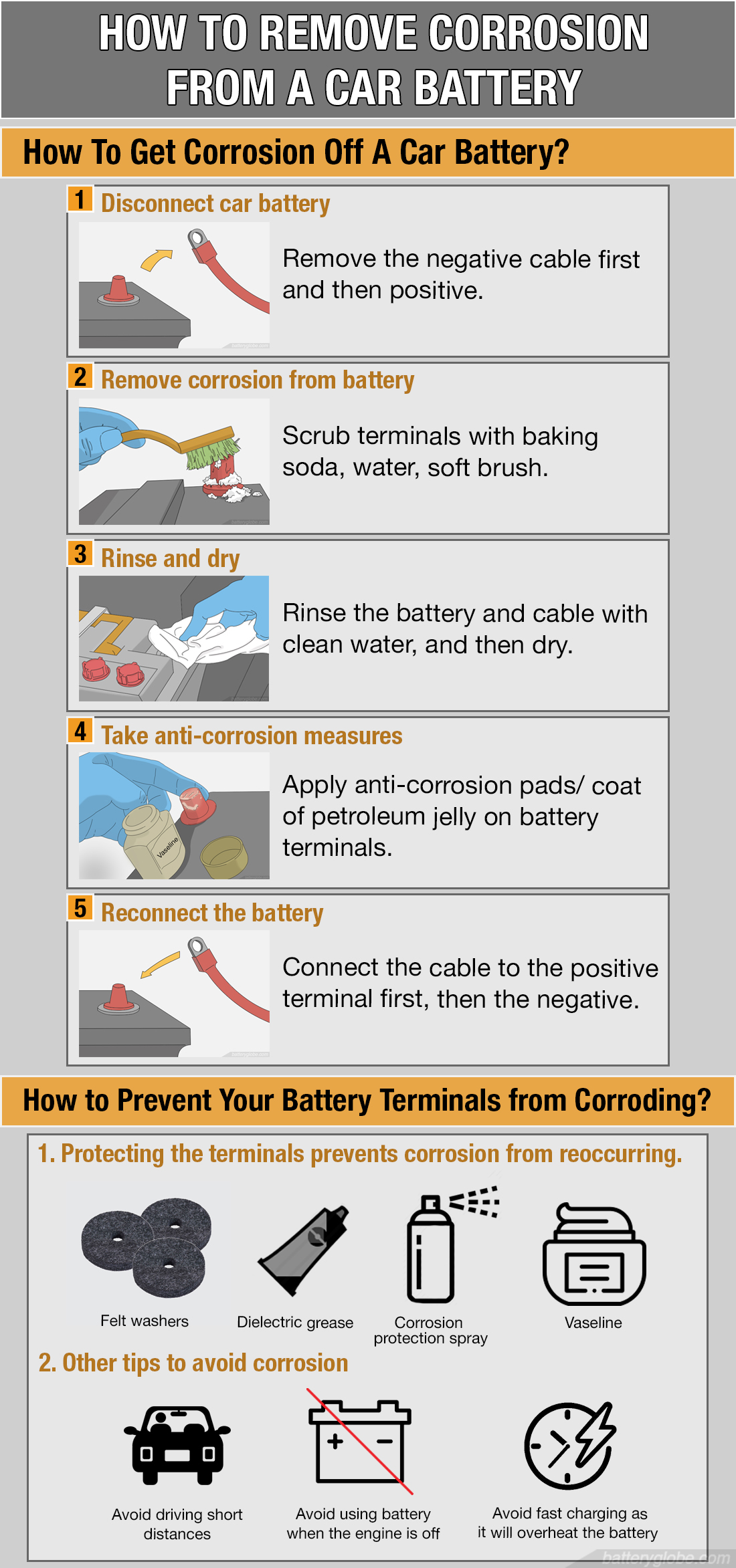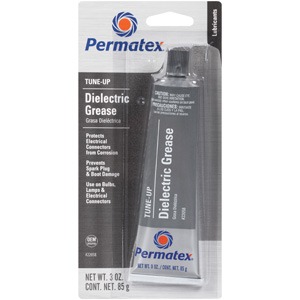Do you suspect that your car’s battery is not performing at an optimal level and unsure why? Battery corrosion is one of the most common causes linked to the drop in performance or even battery life.
If untreated, corrosion will result in issues with the car starting up and can even damage the electrical wiring and the air conditioner.
Luckily, corrosion doesn’t go undetected. It is easy to spot. It forms on the terminals of the battery and is a white, blue substance with a tinge of green.
What Is Battery Corrosion Made Of?
You’ve probably read that battery corrosion forms due to hydrogen. Hydrogen releases from the battery during its charging process and has little to no contribution to corrosion formation.
Corrosion is the result of the sulphuric acid present in the battery. The acid produces an electrical current by creating an ionic difference within the battery.
As the process for generating electrical current occurs, the acid emits fumes. The fumes escape from the slightest bit of opening, usually at the base of the case and the battery terminal.
Over time, as the fumes continue to escape and react with copper on the terminal, corrosion forms. This leads to the battery’s poor performance through the ineffective transmission of the current to the car’s electrical system.
Is Battery Corrosion Dangerous?
Corrosion is common as the battery ages but should be treated as you notice it. Otherwise, it will affect the performance of your car’s battery. After all, the terminal of the battery is what connects it to the car’s electrical system.
Once corrosion forms, it inhibits the transfer of electrical current produced to the systems that need it.
Initially, you will have trouble starting your car, but issues with the car’s onboard computer will surface with time. Overall, corrosion will impact the performance of your car, a reason why it is dangerous.
- Effect of corrosion on the positive terminal: Corrosion on the positive terminal will result in the battery overcharging. This will negatively impact the lifespan of the battery.
- Effect of corrosion on the negative terminal: Corrosion on the negative terminal results in the battery not charging correctly. This results in startup issues with the car and possibly stalling after a short time.
What Color is Battery Corrosion?
The color of battery corrosion may vary, it all depends on the acid vapors.
The most common color seen is blueish-white, which is the result of hydrated copper sulfate. This color appears when the acid vapor reacts with the copper present on the terminal.
If you notice more white than blue, then the corrosion is the result of lead sulfate. This results from the battery’s electron flow, which reacts with the metals present within it and at the terminal.
With time, if the corrosion is not treated, it will develop a rust color.
Guide To Remove Corrosion From Your Car’s Battery
Now that you know the basics of battery corrosion, it’s time we explain how you can rid your car battery of it. Just make sure you take the following precautions when dealing with corrosion:
- Wear a glove to avoid any contact of the content of corrosion with the skin. The acid present can cause irritation or burn.
- Wear safety goggles to prevent them from getting into your eyes.
- Clean the battery in a well-ventilated area.
- If the corrosion makes contact with your skin, make sure to flush the area down with water.
Once you’ve taken the precautions, you can proceed with the following step-by-step guide to removing corrosion.

Step 1: Disconnect your battery
You need to start the process by removing the battery cables to avoid electrical shock. Remove the negative cable first and then positive.
Make sure to do it in this exact order; otherwise you the battery will shock you. The easiest way to identify between the two is the cap color. Black is negative, while red is positive.
Step 2: Remove the corrosion from the battery
Now, it’s time to clean the battery terminal thoroughly, getting rid of the corrosion.
Pour a mix of baking soda and water over the terminal. Let it settle for a few seconds, then start to scrub with a soft brush. Then, use a clamp reamer on the terminal’s lead surface and the brush on the other part to make it anew.
If you’ve decided to clean off the corrosion with your battery fitted in the hood of the car, make sure that the corrosive elements don’t fall on any components of the engine.
We recommend you take the battery out completely to avoid this, but not a necessity.
Step 3: Rinse and dry
Once the corrosion is completely scrubbed off, rinse the battery and cable with clean water.
You can wipe it off with a clean cloth and leave it to dry. If you have an air compressor, you can use it to speed up the drying process.
Step 4: Take anti-corrosion measures
To prevent corrosion from forming again, you can apply anti-corrosion pads. This will protect the battery posts. Another option is to apply a coat of petroleum jelly on the terminals of the battery.
It will improve electricity’s conduciveness between the cable and terminal, and also protect it from future corrosion.
Step 5: Reconnect the battery
To complete the process, you need to reconnect the battery in the reverse order of how you disconnected it.
Connect the cable to the positive terminal first and then the negative. Feel free to apply more petroleum jelly once you connect it.
Cola vs. Baking soda vs. Water: Which cleaning agent should you use for an efficient clean?
You will find tons of sources online that credit cola, baking soda, and water as the perfect cleaning agent for battery corrosion. They all indeed work, but which one works best?
Let’s look at the merit of each as a cleaning agent.
Baking soda and water: The mixture of baking soda and water works well at targeting corrosion. Baking soda contains acid that dissolves corrosion deposits, ensuring you scrub all of it off.
Cola: The content of the cola work similar to baking soda and will remove corrosion deposit. However, the sugar content of the cola will leave a sticky residue, which you will need to clean off.
An alternative to regular cola is diet cola. It won’t leave the car as sticky since it contains less sugar.
Water: Using warm water gets the job done but will require a little extra scrubbing from your end. Water itself doesn’t have any specific component that will assist in removing the deposits.
So, which is the best cleaning solution you ask?
Well, if we had to choose one, then it would be baking soda and water. With it, you don’t need any additional step or effort, and it targets the corrosion deposits, leaving your battery looking as if it was new.
Take a look at the below infographic to see how to remove corrosion and solutions to maintain your car battery.
How To Keep Battery Terminals From Corroding?
Protecting the terminals prevents corrosion from reoccurring. You can use the following methods:
Use felt washers
Felt washers are designed to provide additional protection from corrosion. The washers come in two colors, red and black or green.
Place the red washer on the positive post while the green/black is on the negative. The washers are chemically-treated, reducing the occurrence of corrosion.
To improve the effectiveness of the washer, drop a few drops of oil on it. This will help it settle well on to the post when you fasten it down with the terminal.
Find the best purchasing options for Felt washers online:

Pangda Felt Washers (6 Pieces)

UTSAUTO Washers Fiber (8 Pieces)
Use coating products
Coating products provide an additional layer of protection, making it harder for corrosion to form. You can use any of the following coating products:
- Corrosion protecting spray or gel
- Dielectric grease
- Vaseline or any petroleum jelly
See Coating Products for your battery terminals for sale here:

Permatex 22058 Dielectric Grease

Mission Automotive Dielectric Grease

POR-15 40909 Corrosion Protecting Gel
Grease and vaseline work well but will melt away as the temperature under the hood rises when the car is in motion. This dampens its overall impact.
Most mechanics prefer using products such as Never-Seen and Spray Fluid film as it stays on, providing you protection for a longer period.
How to use dielectric grease?
You will find that many apply dielectric grease after connecting the cable to the post. But it’s better if you apply the grease to the post first and then plug the terminal in and reapply the grease. This will provide optimal protection from corrosion.
Other tips to avoid corrosion
Placing a penny near each battery terminal will result in corrosive elements attaching to the penny instead of the terminal. You can tape it next to it, so the penny doesn’t fall easily.
Keeping your battery maintained is another way to avoid corrosion. This means, avoiding the following:
- Driving short distances.
- The use of battery when the engine is off.
- Fast charging the battery as it will overheat it.
FAQs
Below are some questions individuals usually ask related to battery corrosion.
Is car battery corrosion dangerous to touch?
Battery corrosion is slightly toxic. Therefore, you need to take proper precautions when dealing with it and ensure you don’t consume it in any way. You can touch corrosion with your bare hands, but this can lead to irritation.
Can a bad alternator cause battery corrosion?
The alternator’s primary function is to charge the battery and power the electrics in the car. If it doesn’t function well, neither will your battery.
This will increase the chances of corrosion forming as the battery will rapidly burn acid, leading to fumes that will react with the copper on the terminal resulting in corrosion deposits.
Does corrosion on a battery mean it is in poor condition?
Corrosion is usually linked with an aging battery which has terminal issues. If you notice that corrosion keeps forming on the battery, it is a sign that it is a bad battery.
Should you replace a corroded battery?
Your first option should be to clean the corrosion and apply protective grease or washers. If you still notice corrosion appearing after a few days or weeks, you should consider replacing the battery.
It doesn’t take a rocket scientist to identify and get rid of battery corrosion. However, you want to take the right approach, use cleaning and protection products that are ideal for your car’s battery. Only then will you be able to get rid of corrosion and ensure it stays away.
